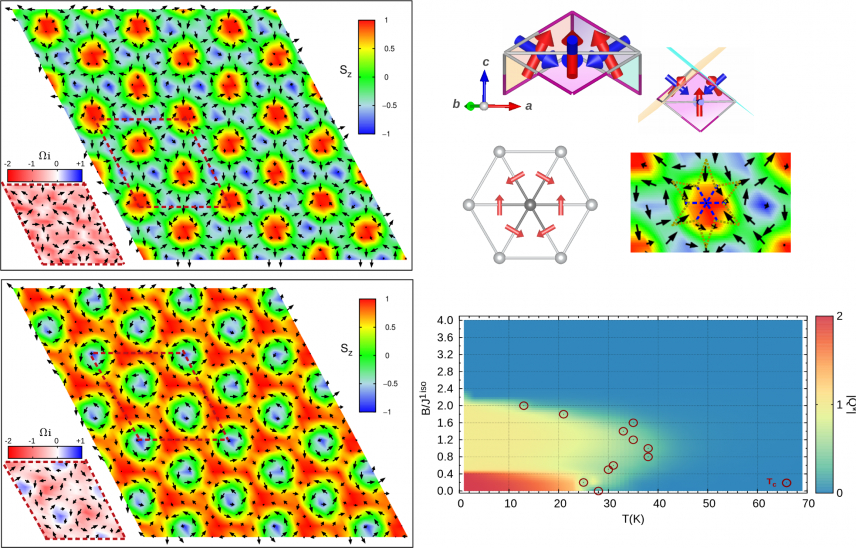Magnetic skyrmions are localized topological spin structures characterized by spins wrapping a unit sphere, and carrying an integer topological charge Q. Their topological properties ensure the inherent stability that makes them technologically appealing for future memory devices.
In most cases, skyrmions are stabilized by magnetic fields in non-centrosymmetric systems displaying the chiral Dzyaloshinskii-Moriya (DM) exchange interaction, while spontaneous skyrmion lattices have been reported in centrosymmetric itinerant magnets with long-range interactions.
In this work, published in the open access Nature Communications journal, by means of density functional theory and Monte-Carlo simulations, D. Amoroso, P. Barone and S. Picozzi (CNR-SPIN in Chieti and Rome) show that a thermodynamically-stable skyrmionic lattice with a well-defined topology and chirality of the spin texture in absence of DM and Zeeman interactions, can be stabilized by the anisotropic part of the short-range symmetric exchange, assisted only by the exchange frustration. In particular, the symmetric anisotropic exchange tensor shows large off-diagonal terms, which - due to the peculiar non-coplanar arrangement of the spin-ligand plaquettes in the triangular lattice of the magnetic cations - induce frustration in the relative orientation of spins by setting non-coplanar principal axes. Combined with the exchange frustration due to competing ferromagnetic first-neighbor and antiferromagnetic third-neighbors, this results in a non-trivial arrangement of spins with well-defined topology: we predict a spontaneous high-Q antiskyrmion lattice (Q=2) with fixed chirality, undergoing, under magnetic field, a topological phase transition to a more conventional skyrmion lattice (Q=1) in a semiconducting 2D-magnet, the centrosymmetric NiI2 monolayer.
The proposed novel mechanism enlarges, on the one hand, the kind of magnetic interactions able to drive the stabilization of topological spin structures, on the other hand, the class of materials able to host spontaneous skyrmionic lattices with definite chirality, including also magnetic semiconductors with short-range anisotropic interactions.
Danila Amoroso, Paolo Barone and Silvia Picozzi, “Spontaneous skyrmionic lattice from anisotropic symmetric exchange in a Ni-halide monolayer”. Nature Communications 11, 5784 (2020). https://doi.org/10.1038/s41467-020-19535-w


